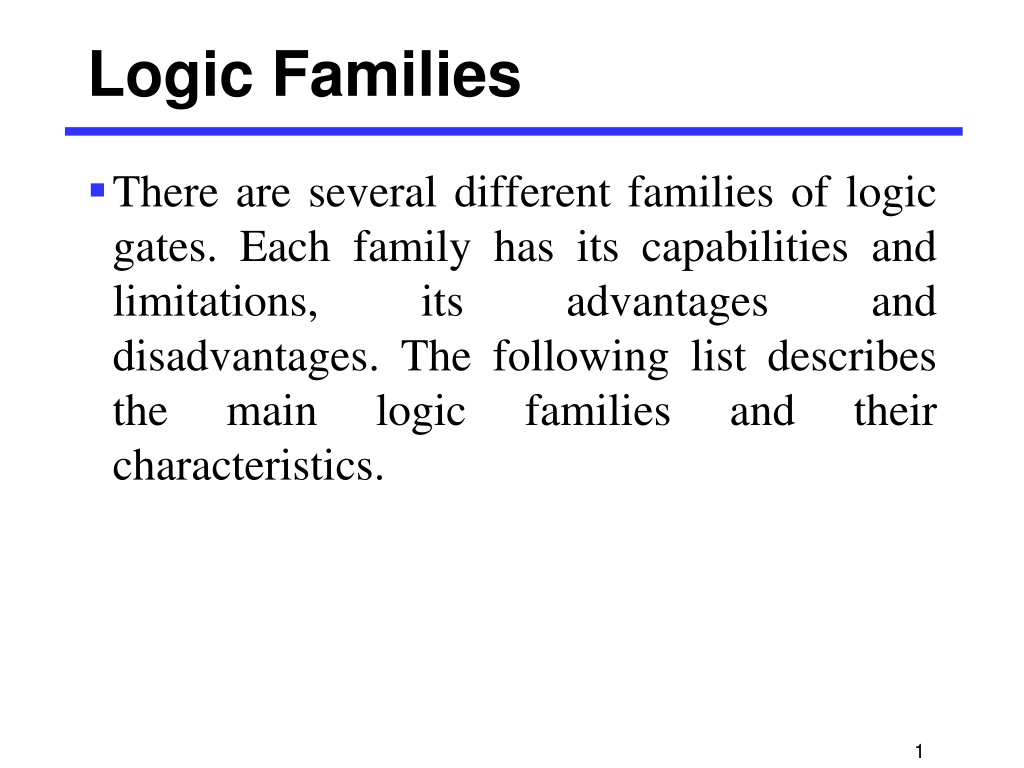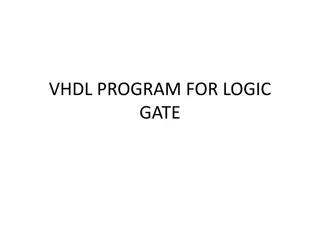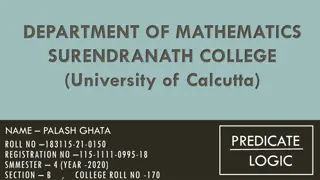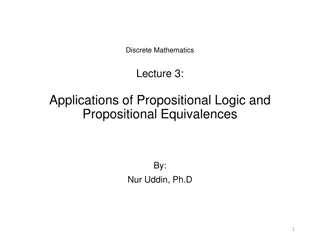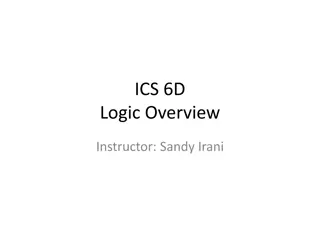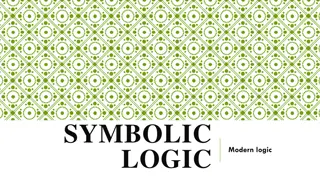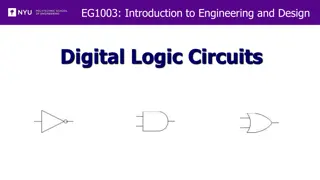Logic Families
Logic families such as Diode Logic (DL), Resistor-Transistor Logic (RTL), and Diode-Transistor Logic (DTL) each have distinct capabilities and limitations when it comes to performing logic functions. While DL gates are simple and inexpensive but limited in functionality, RTL gates offer both normal and inverted signals but draw significant current. DTL combines diodes and transistors for improved performance. Understanding these logic families is crucial for designing efficient logic circuits.
Download Presentation

Please find below an Image/Link to download the presentation.
The content on the website is provided AS IS for your information and personal use only. It may not be sold, licensed, or shared on other websites without obtaining consent from the author. Download presentation by click this link. If you encounter any issues during the download, it is possible that the publisher has removed the file from their server.
E N D
Presentation Transcript
Logic Families There are several different families of logic gates. Each family has its capabilities and limitations, its disadvantages. The following list describes the main logic characteristics. advantages and families and their 1
Logic Families Diode Logic (DL): Diode logic gates use diodes to perform AND and OR logic functions. Diodes have the property of easily passing an electrical current in one direction, but not the other. Thus, diodes can act as a logical switch. 2
Logic Families Diode Logic (DL): Diode logic gates are very simple and inexpensive, and can be used effectively in However, they cannot be used extensively, as they tend to degrade digital signals rapidly. In addition, they cannot perform a NOT function, so their usefulness is quite limited. specific situations. 3
DIODE 4
Logic Families Resistor-transistor Transistors signals, which also amplify and invert the resulting combined additional transistor is included to re-invert the output signal. This combination provides clean output signals and either inversion or non-inversion as needed. logic gates use to combine multiple input signal. Often an 5
Logic Families RTL gates are almost as simple as DL gates, and remain inexpensive. They also are handy because both normal and inverted signals are often available. However, they do draw a significant amount of current from the power supply for each gate. Another limitation is that RTL gates cannot switch at the high speeds used by today's computers, although they are still useful in slower applications. 6
Logic Families Resistor-Transistor Logic (RTL): The basic circuit of the RTL logic family is NOR. Each input is associated with one resistor and one transistor. 7
RESISTOR 8
Logic Families Diode-Transistor Logic (DTL): By letting diodes perform the logical AND or OR function and then amplifying the result with a transistor, we can avoid some of the limitations of RTL. DTL takes diode logic gates and adds a transistor to the output, in order to provide logic inversion and to restore the signal to full logic levels. 10
Logic Families Diode-Transistor Logic (DTL): The basic circuit in the DTL logic is the NAND gate. Each input associated with one diode. The diode and resistor form an AND gate. The transistor amplifies the output 11
Logic Families Transistor-Transistor Logic (TTL): The physical construction of integrated circuits made it more effective to replace all the input diodes in a DTL gate with a transistor, built with multiple emitters. The result is transistor- transistor logic, which became the standard logic circuit in most applications for a number of years. 12
Logic Families Transistor-Transistor Logic (TTL): As the state of the art improved, TTL integrated circuits were adapted slightly to handle a wider range of requirements, but their basic functions remained the same. These devices comprise the 7400 family of digital ICs. 13
Logic Families Transistor-Transistor Logic (TTL): uses multiple emitter transistor at the input 14
Logic Families Emitter-Coupled Logic (ECL): Also known as Current Mode Logic (CML), ECL gates are specifically designed to operate at extremely high speeds, by avoiding the "lag" inherent when transistors are allowed to become saturated. Because of this, however, these gates demand substantial amounts of electrical current to operate correctly. 15
Logic Families Emitter-Coupled Logic (ECL): Each input is connected to the base of transistor. 16
Logic Families CMOS Logic: One factor is common to all of the logic families we have listed above: they use significant amounts of electrical power. Many applications, especially powered ones, require that the use of power be absolutely minimized. To accomplish this, the CMOS (Complementary Semiconductor) logic family was developed. This family uses enhancement-mode MOSFETs as its transistors, and is so designed that it requires almost no current to operate. portable, battery- Metal-Oxide- 17
Logic Families CMOS Logic: CMOS circuits use a combination of p- type and n-type metal oxide semiconductor field- effect transistor (MOSFETs). CMOS gates are, however, severely limited in their speed of operation. Nevertheless, they are highly useful and effective in a wide range of battery- powered applications. 18
Logic Families Characteristics of Logic Families The main characteristics of Logic families include: Speed Fan-in Fan-out Noise Immunity Power Dissipation 19
Logic Families Speed: determined application of input and change in the output of the circuit. Fan-in: It determines the number of inputs the logic gate can handle properly with out disturbing the output level. Fan-out: Determines the number of circuits that a gate can drive simultaneously by the output with out disturbing the output level. Speed of the a logic time circuit between is by the 20
Logic Families Noise Immunity: Maximum noise that a circuit can withstand without affecting the output. Power: When a circuit switches from one state to the other, power dissipates. 21
